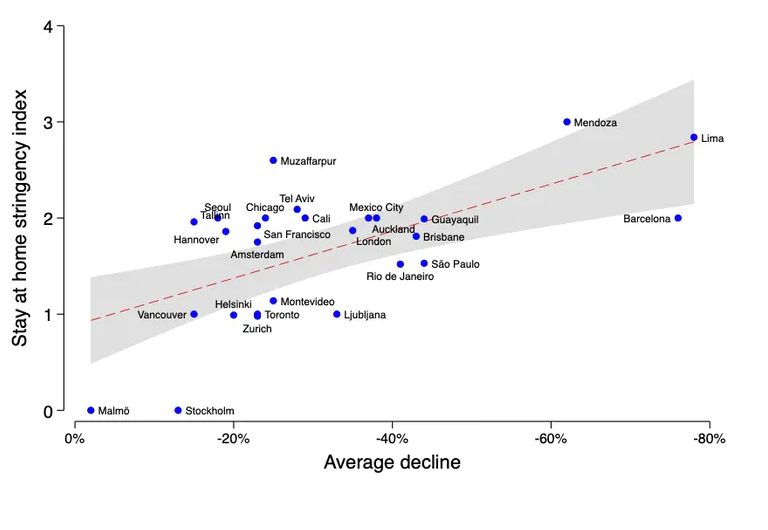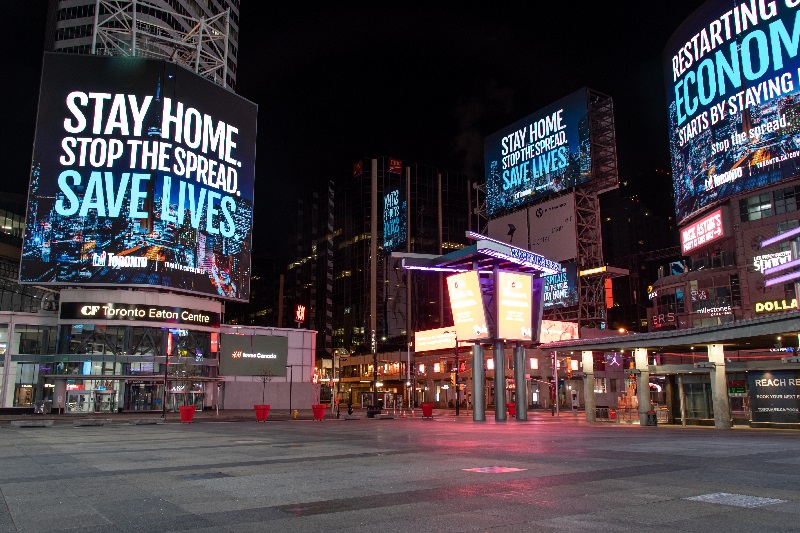Soon after the first lockdowns started, newspaper articles were ripe with speculation and reports about the effect of the pandemic on crime around the globe. Many reports suggested there would be a rapid fall in street crime, while others indicated a possible rise in lootings, burglaries of commercial properties and domestic violence.
When we discussed the potential implications of lockdowns in an initial working paper, we assumed that crime in public spaces would go down, but that it might increase in the long term as the effects of unemployment and the pandemic’s financial strains are felt.
This led us to the idea of examining and comparing crime patterns in cities around the world. In particular, we thought that the lockdown was a unique opportunity to test the validity of ‘routine activity theory’, which is rooted in the idea that crime feeds on opportunities embedded in the routines of daily life.
So, we looked at the daily number of six types of police-recorded crimes – burglary, theft, assault, robbery, vehicle theft and homicide – across a number of cities around the world. For most cities, the time we looked at stretched from the beginning of 2018 or 2019 through to mid-2020.

Cities with stronger stay-at-home measures tended to see a greater decline in crime. Nivette et al. A global analysis of the impact of COVID-19 stay-at-home restrictions on crime. Nat Hum Behav (2021). doi.org/10.1038/s41562-021-01139-z, CC BY
We attempted to select cities that would maximise the geographical coverage of our study as well as capture the influence of a range of different policy responses aimed at reducing the spread of COVID-19. We also wanted to make sure that we covered cities in developing countries. In many cases, however, daily crime data was simply not available or we didn’t get a response to our requests. The final sample included 27 cities across 23 countries.
Our findings showed that the number of daily crimes declined in the weeks following lockdowns being introduced. On average, the overall reduction in daily crime was -37% across the cities in the sample.
Our findings showed that the number of daily crimes declined in the weeks following lockdowns being introduced. On average, the overall reduction in daily crime was -37% across the cities in the sample. However, there were differences across crime types and cities. Street crimes like theft (-47%) and robbery (-46%) declined most, while the drop in the number of murders was substantially smaller (-14%) and not statistically significant.
The lack of a significant decline in murder was a surprise. Especially in high-crime cities such as Rio de Janeiro, murders are often linked to gang activities and conflicts between young men. Despite restrictions limiting interactions for many people, the findings suggest that lockdowns seemed to do little to change the behaviour of those involved in serious violence.
In cities with more stringent stay-at-home orders, we saw larger declines in street crime compared to cities with fewer constraints on public life. For example, in Stockholm, Sweden, where there were little to no stay-at-home restrictions, on average daily crime declined by 13%. By contrast, in Lima, Peru, which experienced some of the most stringent stay-at-home restrictions in the sample, the daily number of street crimes declined on average by 78% in the weeks following lockdown.
In other words, the combination of stay-at-home orders, shops and schools closing, restrictions on public transport and the disappearance of tourism meant that many opportunities for urban crime simply no longer existed.
With people staying at home, it also became harder to break into empty flats or houses. And with streets and public transport empty, offenders may have been concerned about an increased risk of being stopped simply for breaking lockdown orders. Our findings suggest that this change in routine activities and decline in opportunities for crime is the most plausible explanation for the fall in offences recorded, at least in the short term.
How long did it last?
This hibernation of crime in public spaces was relatively short lived. Across the world, crime levels started to creep up again a few weeks after lockdowns began. We are currently gathering more data to examine the long-term effects of lockdown measures in the second half of 2020 and into 2021. In particular, we’re interested in whether there was a ‘boomerang’ effect, with crime (at least temporarily) overshooting pre-pandemic levels after having fallen.
It’s important to mention as well that there are indications that in some countries violence at home increased following lockdowns, and also that cybercrime may have increased. However, the data we used doesn’t cover these important problems, so we are not able to determine whether crime opportunities merely shifted from offline to online environments.
Our findings may also help us to better understand long-term crime trends. Lockdowns are obviously not a way to reduce crime, but our findings suggest that a change in opportunities can lead to a decline in crime. This may be a useful insight when designing strategies to reduce crime in the future.
This article is republished from The Conversation under a Creative Commons licence. Read the original article here.
About the authors
 Dr Amy Nivette is an Assistant Professor in Sociology at Utrecht University, the Netherlands. Previously, she was a Postdoctoral Prize Research Fellow at Nuffield College, University of Oxford, and completed her PhD in criminology at the Institute of Criminology, University of Cambridge, UK. Her current research investigates how injustice, insecurity, and marginalisation intersect to affect citizens’ perceptions and use of justice institutions, and the relation to crime and violence.
Dr Amy Nivette is an Assistant Professor in Sociology at Utrecht University, the Netherlands. Previously, she was a Postdoctoral Prize Research Fellow at Nuffield College, University of Oxford, and completed her PhD in criminology at the Institute of Criminology, University of Cambridge, UK. Her current research investigates how injustice, insecurity, and marginalisation intersect to affect citizens’ perceptions and use of justice institutions, and the relation to crime and violence.
 Dr Manuel Eisner is Professor of Comparative and Developmental Criminology at the University of Cambridge. He studied history at the University of Zurich and holds a PhD in sociology. He has published several authored or edited books and over 100 journal articles and book chapters in English, German, Spanish and French. His academic work revolves around the explanation of the causes, consequences and the prevention of interpersonal violence across human societies.
Dr Manuel Eisner is Professor of Comparative and Developmental Criminology at the University of Cambridge. He studied history at the University of Zurich and holds a PhD in sociology. He has published several authored or edited books and over 100 journal articles and book chapters in English, German, Spanish and French. His academic work revolves around the explanation of the causes, consequences and the prevention of interpersonal violence across human societies.


